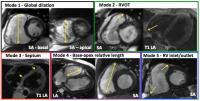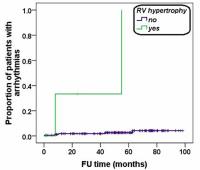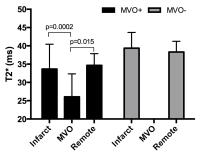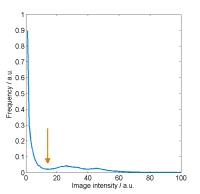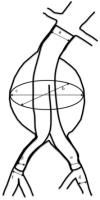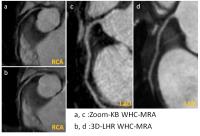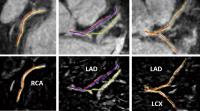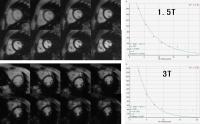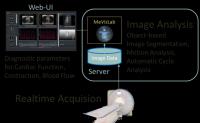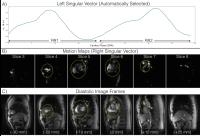|
2582.
 |
Unattended Processing of 4D Flow MRI in the Aorta: Assessment of
Aortic Dimension, Blood Flow, and Demographics in 782 Subjects
Julio Garcia1, Alex J. Barker1,
Susanne Schnell1, Jeremy D. Collins1,
James C. Carr1, and Michael Markl1,2
1Radiology, Northwestern University, Chicago, IL,
United States, 2Biomedical
Engineering, Northwestern University, Evanston, IL, United
States
The processing of time-resolved 3D phase-contrast MRI with
three-directional velocity encoding (4D flow MRI) cases can
be highly time consuming given the large multi-dimensional
datasets (3D+time of the cardiac cycle+3-directional blood
flow velocities). However, the fully automated processing of
cases in large databases is still challenging. The purpose
of this study was to introduce an automated workflow
allowing the unattended retrospective processing of aortic
4D flow MRI data from a large database of subjects.
|
|
2583.
 |
Variability of flow parameters when subjected to changes of MR
acquisitions parameters in 4D flow MRI using a realistic
thoracic aortic phantom.
Cristian Montalba1, Jesus Urbina1,2,
Julio Sotelo1,3, Marcelo Andia1,4,
Cristian Tejos1,3, Pablo Irrarazaval1,3,
Israel Valverde5,6, and Sergio Uribe1,4
1Biomedical Imaging Center, Pontificia
Universidad Católica de Chile, Santiago, Chile, 2School
of Medicine, Pontificia Universidad Católica de Chile,
Santiago, Chile, 3Electrical
Engineering, Pontificia Universidad Católica de Chile,
Santiago, Chile, 4Radiology
Department, Pontificia Universidad Católica de Chile,
Santiago, Chile, 5Institute
of Biomedicine of Seville, Universidad De Sevilla, Seville,
Spain, 6Cardiology
Unit, Hospital Virgen del Rocio, Universidad de Sevilla,
Seville, Spain
4D flow is a MRI technique characterized by long scanning
times. Because of that, it is difficult to study the
variability of flow parameters when subjected to changes of
the MR parameters. The purpose of this work is to study the
variability of different flow parameters due to changes of
spatial and temporal resolutions in 4D flow acquisitions
through controlled experiments using a realistic normal
adult thoracic aortic phantom. We conclude that changing the
spatial and temporal resolutions in the 4D flow imaging
greatly affects different flow parameters with induced
errors of up to 23.9%.
|
|
2584.
 |
Background Phase Correction for Quantitative Phase-Contrast MRI
Rizwan Ahmad1, Ning Jin2, and Orlando
P Simonetti3
1Electrical and Computer Engineering, The Ohio
State University, Columbus, OH, United States, 2Siemens
Healthcare, Columbus, OH, United States, 3Radiology
and Internal Medicine, The Ohio State University, Columbus,
OH, United States
Virtually every phase-contrast MRI (PC-MRI) measurement is
contaminated with background phase (BP) from eddy currents
and concomitant gradient terms. A widely reported method to
correct BP relies on a polynomial fitting of the static
pixels within regions of static tissue. This method requires
sufficient static tissue in close proximity to the region of
interest—a requirement that cannot be met for imaging of the
heart or great vessels. In this work, we propose a BP
correction method that leverages information from multiple
slices collected under identical conditions but with
different table positions.
|
|
2585.
 |
Does Respiratory Motion Influence Tissue Phase Mapping
Velocities? 
Jan Paul1, Stefan Wundrak1, Peter
Bernhardt1, Wolfgang Rottbauer1, and
Volker Rasche1
1Internal Medicine II, University Hospital of
Ulm, Ulm, Germany
Cartesian Tissue Phase Mapping (TPM) usually necessitates
respiratory navigators or other means of motion
selection/correction to avoid ghosting artifacts. In radial
MRI, however, motion artifacts result in image blurring
rather than ghosting, which might allow using all
respiratory states for reconstruction. The aim of this study
is to investigate the influence of respiratory motion on
velocities obtained from radial Tissue Phase Mapping MRI.
Only small biases towards reduced velocity peaks were found
in ungated compared to motion-compensated reconstructions.
Overall velocity agreement of ungated data was very high
compared to gated reconstructions.
|
|
2586.
 |
Characterization of Pulsatile Cerebrospinal Fluid Motion Among
Young, Elderly and Idiopathic Normal Pressure Hydrocephalus By
Correlation Mapping Technique 
Satoshi Yatsushiro1, Saeko Sunohara2,
Naokazu Hayashi3, Akihiro Hirayama3,
Mitsunori Matsumae3, Afnizanfaizal Bin Abdullah4,
and Kagayaki Kuroda2
1Course of Science and Technology, School of
Science and Technology, Tokai University, Hiratsuka,
Kanagawa, Japan, 2Course
of Electrical and Electronic Engineering, Graduate School of
Engineering, Tokai University, Hiratsuka, Kanagawa, Japan, 3Department
of Neurosurgery, Tokai University School of Medicine,
Isehara, Kanagawa, Japan, 4Department
of Software Engineering, Faculty of Computing, Universiti
Teknologi Malaysia, Johor Bahru, Malaysia
Correlation mapping technique composed of
delay time and correlation coefficient mapping to
characterize propagation properties of cerebrospinal fluid
(CSF) motion was applied to young, elderly healthy and
idiopathic normal pressure hydrocephalus (iNPH) patient
groups for classification. Brightness of the color of
maximum correlation map was adjusted according to the
amplitude of the CSF velocity waveform for assisting
clinicians to understand the propagation properties
intuitively. The groups were classified by quantifying the
standard deviation of the correlation distributing in the
intracranial CSF space. The technique was expected to
classify diseases related to CSF dynamics such as iNPH.
|
|
2587.
 |
Temporal Dynamics and Sampling Rate Effects for Background Phase
Estimates in 4D Flow MRI
Michael Loecher1, Peng Hu1, and Daniel
B Ennis1,2
1Department of Radiological Sciences, University
of California, Los Angeles, CA, United States, 2Biomedical
Physics, University of California, Los Angeles, CA, United
States
4D Flow phase contrast MRI acquisitions inherently require a
measure of background phase to remove phase contributions
from non-velocity based components. The temporal dynamics
of this background phase are not well understood.
Consequently, the background phase may be measured too
infrequently or too often for accurate and/or time efficient
measurements. The purpose of this work was: 1) to measure
the temporal dynamics of the background phase with high
temporal resolution; and 2) to demonstrate methods of
selecting time optimal background phase sampling strategies
that improve the measurement efficiency of 4D Flow
acquisitions.
|
|
2588.
 |
Velocity Transfer Function from Phase Contrast MRI - A
Non-Invasive Method for Assessing Pulmonary Arterial Stiffness
and Impedance 
Himanshu Gupta1,2, Ankur Gupta1, and
Thomas S Denney3,4
1Department of Medicine, Division of
Cardiovascular Disease, University of Alabama at Birmingham,
Birmingham, AL, United States, 2VA
Medical Center, Birmingham, AL, United States, 3Auburn
University MRI Research Center, Auburn University, Auburn,
AL, United States, 4Electrical
and Computer Engineering, Auburn University, Auburn, AL,
United States
Pulmonary arterial (PA) impedance accounts for pulsatile
blood flow through elastic pulmonary arteries as compared to
static pulmonary vascular resistance. Increased PA impedance
is an early physiological manifestation of PA remodeling.
Currently, PA impedance can only be detected invasively, is
expensive and cumbersome to calculate and not done in
routine clinical practice. Non-invasive assessment of PA
impedance can provide insights in evaluation of patients
with normal PA pressures or mild pulmonary hypertension such
as in patients with chronic obstructive lung disease. We
propose a novel non-invasive parameter, the velocity
transfer function (VTF), which is related to PA stiffness
and impedance.
|
|
2589.
 |
3D quantification of Vorticity, Helicity, Kinetic Energy and
Energy loss in the Left Ventricle from 4D flow data using a
finite element method
Julio Sotelo1,2,3, Jesús Urbina1,4,
Bram Ruijsink5, David Nordsletten5,
Israel Valverde6,7, Cristian Tejos1,2,8,
Pablo Irarrazaval1,2,8, Marcelo Andia1,4,8,
Daniel E Hurtado3,8, and Sergio Uribe1,4,8
1Biomedical Imaging Center, Pontificia
Universidad Catolica de Chile, Santiago, Chile, 2Electrical
Engineering Department, Pontificia Universidad Catolica de
Chile, Santiago, Chile, 3Structural
and Geotechnical Engineering Departement, Pontificia
Universidad Catolica de Chile, Santiago, Chile, 4Radiology
Department, School of Medicine, Pontificia Universidad
Catolica de Chile, Santiago, Chile, 5Biomedical
Engineering Department, King's College London, London,
United Kingdom, 6Pediatric
Cardiology Unit, Hospital Virgen del Rocio, Seville, Spain, 7Cardiovascular
Pathology Unit, Institute of Biomedicine of Seville (IBIS),
Hospital Virgen del Rocio, Seville, Spain, 8Biological
and Medical Engineering Institute, Schools of Engineering,
Medicine and Biological Sciences, Pontificia Universidad
Catolica de Chile, Santiago, Chile
A quantitative characterization of vortex flow as turbulence
and energy may offer a novel index of left ventricle (LV)
dysfunction not available in conventional indexes. In this
work we propose a novel method based on finite element
interpolations to obtain a 3D quantitative maps of
vorticity, helicity density, kinetic energy, and energy loss
derived from 4D-flow data sets of the LV.? This new method
may offer a novel index of LV dysfunction, permitting
identify the vortex ring and the magnitude of turbulence
values not available in conventional indexes. In future work
we pretend validate clinically our method with patient
data.
|
|
2590.
 |
Evaluate Right Ventricular Energy Propagation for Patients With
Repaired Tetralogy of Fallot by Using Phase-Contrast MRI
Meng-Chu Chang1, Ming-Ting Wu2, Marius
Menza3, Mao-Yuan Su4, Hung-Chieh Huang2,
and Hsu-Hsia Peng1
1Department of Biomedical Engineering and
Environmental Sciences, National Tsing Hua University,
Hsinchu, Taiwan, 2Department
of Radiology, Kaohsiung Veterans General Hospital,
Kaohsiung, Taiwan, 3Medical
Physics, Department of Radiology, University Hospital
Freiburg, Freiburg, Germany, 4Department
of Medical Imaging, National Taiwan University Hospital,
Taipei, Taiwan
The association between right ventricle (RV) volume or
pressure overloading pathology and intraventricular flow of
repaired tetralogy of Fallot (rTOF) patient is still
unclear. Therefore, we evaluated RV input- and output
kinetic energy and intraventricular flow patterns for rTOF
patients to speculate the energy propagation by using
phase-contrast MRI. During systole, rTOF patients presented
higher RV output KE. Moreover, in rTOF patients, the blood
flow filled into RV with a high velocity, accompanying
several local vortices. In conclusion, higher output KE and
the visualization of intraventricular vectors helped to
comprehend the energy propagation in RV.
|
|
2591.
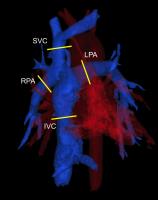 |
Kinetic Energy Distributions in Fontan Circulation - Evaluation
of Respiration Effects
Alejandro Roldán-Alzate1,2, Eric Schrauben3,4,
Oliver Wieben2,3, and Christopher J Francois2
1Mechanical Engineering, University of Wisconsin
- Madison, Madison, WI, United States, 2Radiology,
University of Wisconsin - Madison, Madison, WI, United
States, 3Medical
Physics, University of Wisconsin - Madison, Madison, WI,
United States, 4Centre
for Advanced MRI, Auckland, New Zealand
The purpose of this study was to evaluate changes in blood
flow and kinetic energy distribution between inspiration and
expiration in TCPC patients for assessing efficiency of the
system using 4D flow MRI. Six TCPC patients were imaged
using a PC-VIPR scheme that allows for double gating to the
ECG and respiratory cycles providing flow data for separate
respiratory phases. Results exhibit greater
respiratory-induced flow changes within a single subject
than previous work has shown in the same analysis performed
on healthy controls, suggesting that respiration plays a
larger role in regulating flow in these patients.
|
|
2592.
 |
Finite-Element Computational Fluid Dynamics Simulations
Constrained by Phase-Contrast MRI Data 
Giordanno B. F. Borges1, Ivan R. Siqueira2,
Joao L. A. Carvalho3, Jon-Fredrik Nielsen4,
and Vinicius C. Rispoli5
1Department of Mathematics, University of
Brasilia, Brasilia, Brazil, 2Department
of Mechanical Engineering, Pontifical Catholic University of
Rio de Janeiro, Rio de Janeiro, Brazil, 3Department
of Electrical Engineering, University of Brasilia, Brasilia,
Brazil, 4Biomedical
Engineering, University of Michigan, Ann Arbor, MI, United
States, 5UnB
Gama College, University of Brasilia, Brasilia, Brazil
Phase-contrast MRI (PC-MRI) data has been vastly used as
boundary conditions in computational fluid dynamics
(CFD) simulations. Recently, many authors also used
measured flow data to enforce CFD solutions, based on
the finite volume method (FVM). On the other hand, the
finite element method (FEM) has notable advantages over
FVM, such as higher order accuracy and more
flexibility dealing with complex geometries. This work
presents a finite-element implementation of a
MRI-constrained CFD solver. This hybrid solver can be
used to regularize PC-MRI data, providing solutions
closer to the PC-MRI measurements than pure CFD.
Feasibility of this approach is demonstrated using a
modified 2D discretization of the Navier-Stokes and
continuity equations, using FEM. In this demonstration,
two velocity components were taken from a 4D PC-MRI
dataset, and used to constrain the CFD solution over a
2D domain.
|
|
2593.
 |
Energy loss and turbulent formations reveal the pressure loss in
coarctation flows: A novel 4D Flow MRI-Based quantification
method using a finite element approach
Julio Sotelo1,2,3, Jesús Urbina1,4,
Cristian Montalba1, Israel Valverde5,6,
Cristian Tejos1,2,7, Pablo Irarrazaval1,2,7,
Marcelo Andia1,4,7, Daniel E Hurtado3,7,
and Sergio Uribe1,4,7
1Biomedical Imaging Center, Pontificia
Universidad Catolica de Chile, Santiago, Chile, 2Electrical
Engineering Department, Pontificia Universidad Catolica de
Chile, Santiago, Chile, 3Structural
and Geotechnical Engineering Departement, Pontificia
Universidad Catolica de Chile, Santiago, Chile, 4Radiology
Department, School of Medicine, Pontificia Universidad
Catolica de Chile, Santiago, Chile, 5Pediatric
Cardiology Unit, Hospital Virgen del Rocio, Seville, Spain, 6Cardiovascular
Pathology Unit, Institute of Biomedicine of Seville (IBIS),
Hospital Virgen del Rocio, Seville, Spain, 7Biological
and Medical Engineering Institute, Schools of Engineering,
Medicine and Biological Sciences, Pontificia Universidad
Catolica de Chile, Santiago, Chile
Aortic coarctation (CoA) cause an irreversible pressure loss
post-CoA given by the energy dissipation, increasing the
ventricular workload. Turbulent flows through CoA generate
an irreversible damage in the surrounding tissue for
mechanical stresses. We implement a finite elements method
to obtain 3D maps of energy loss, kinetic energy, vorticity
and helicity from 4D flow data. We performed an in-vitro
study that related the pressure gradient, pulse wave
velocity and elastic modulus with the energy loss and
vorticity and helicity parameters. Concluding that our
method may allow assessing the severity of the CoA and the
identification of the regions affected.
|
|
2594.
 |
Validation of "WaVelocity" Image Analysis Toolbox for Cardiac
Magnetic Resonance Pulse Wave Velocity Measurements
Danilo Babin1, Daniel Devos2, and
Patrick Segers3
1TELIN, Ghent University, Ghent, Belgium, 2Ghent
University Hospital, Ghent, Belgium, 3ibiTech-bioMMeda,
Ghent University, Ghent, Belgium
The purpose is to validate our cardiovascular image analysis
toolbox "WaVelocity" for measuring pulse wave velocity (PWV)
from cardiac magnetic resonance images against PWV
measurements of in-place pressure catheter. The validation
was performed using two phantoms: a straight latex tube and
an aortic phantom with two different water flow rates.
Phase-Contrast para-sagittal image sequences in multiple
planes were processed with our image analysis software.
Ground truth PWV values were calculated from pressure curves
measured by pullback of the catheter. The results show
sufficiently high correspondence between calculated MR and
catheter PWV to plan for clinical use.
|
|
2595.
 |
Accelerated Phase-Contrast MRI using Hybrid One- and Two-sided
Flow-Encodings Only (HOTFEO)
Da Wang1,2, Jiaxin Shao1, Daniel B
Ennis1,2, and Peng Hu1,2
1Radiology, University of California, Los
Angeles, Los Angeles, CA, United States, 2Biomedical
Physics, University of California, Los Angeles, Los Angeles,
CA, United States
In conventional 4D-flow phase-contrast MRI, each cardiac
phase acquires the flow-compensated and three-directional
flow-encoded echoes, which often limits the achievable
temporal-resolution and temporal-footprint. This can result
in under-estimation of maximum peak velocity. Herein, we
propose a fast 4D-flow strategy that eliminates the
flow-compensated acquisition using hybrid one- and two-sided
flow encoding only (HOTFEO). The flow-compensated background
phase is derived from three-directional flow-encoded data
based on a velocity direction constraint that assumes the
velocity direction, not the magnitude, changes very little
between two cardiac phases. HOTFEO provides accurate blood
flow and velocity measurements compared with conventional
4D-flow technique.
|
|
2596.
 |
MRI flow quantification of Head and Neck arteries
Jérémie Bettoni1, Gwenaël Pagé2,
Stéphanie Dakpé1, Jean-Marc Constans3,
Sylvie Testelin1, Bernard Devauchelle1,
and Olivier Balédent2,4
1Maxillo-Faciale surgery, Amiens Hospital,
Amiens, France, 2BioFlow
Image, University of Picardie Jules Verne, Amiens, France, 3Diagnostic
Radiology, Amiens Hospital, Amiens, France, 4Department
of Image Processing, Amiens Hospital, Amiens, France
The aim of this study is to create the first physiological
database of the blood flow quantification in the external
carotid tree in order to help the surgeon in facial
reconstruction by free flap. An original protocol
association with 32 head coils channel and microscopic coil
is created and 2D PC-MRI are performed on arteries from head
and neck area. Blood flow average for each artery is 17
mL/min in superior thyroid artery, 6.5 mL/min in lingual
artery, 30.5 mL/min in facial artery, 23.5 mL/min in
internal maxillary artery, 21.5 mL/min in superficial
temporal artery.
|
|
2597.
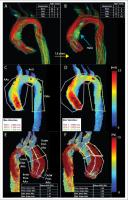 |
Monitoring the Disease Progression and Aortic Hemodynamics of
Pediatric Bicuspid Aortic Valve Patients Using Longitudinal 4D
Flow MRI 
Michael Rose1, Emilie Bollache2, Kelly
Jarvis2,3, Alex Barker2, Susanne
Schnell2, Bradley Allen2, Joshua
Robinson4,5, Michael Markl2,3, and
Cynthia Rigsby1,2
1Medical Imaging, Ann & Robert H. Lurie
Children's Hospital of Chicago, Chicago, IL, United States, 2Radiology,
Northwestern University, Chicago, IL, United States, 3Biomedical
Engineering, Northwestern University, Chicago, IL, United
States, 4Pediatrics,
Northwestern University, Chicago, IL, United States, 5Pediatric
Cardiology, Ann & Robert H. Lurie Children's Hospital of
Chicago, Chicago, IL, United States
Over the course of two 4D flow MRI studies (mean duration
between studies: 19 months), 12 pediatric BAV patients were
evaluated for any changes in aortic hemodynamics.
Hemodynamics were characterized via visual grading of flow
patterns, peak systolic velocity and regional mean wall
shear stress. There were no significant changes in visual
grading scores, peak systolic velocities or mean wall shear
stress values between baseline and follow up studies
suggesting little BAV disease progression during this time.
|
|
2598.
 |
Perioperative assessment of aortic tissue at risk for
dysfunction in patients undergoing valve and/or aortic
replacement using 4D flow MRI 
Emilie Bollache1, Paul W.M. Fedak2,3,
Pim van Ooij1, David Guzzardi2, S.
Chris Malaisrie3, Alex Hong1, Patrick
M. McCarthy3, James Carr1, Jeremy
Collins1, Michael Markl1,4, and Alex
J. Barker1
1Department of Radiology, Northwestern
University, Chicago, IL, United States, 2Department
of Cardiac Sciences, University of Calgary, Calgary, AB,
Canada, 3Division
of Surgery-Cardiac Surgery, Northwestern University,
Chicago, IL, United States, 4Department
of Biomedical Engineering, Northwestern University, Chicago,
IL, United States
The effect of the type of aortic surgery in patients with
aortopathy is not well known. We studied 23 patients who
underwent 4D flow MRI both before and after aortic valve
(AVR) and/or ascending aortic (AAR) replacement, from which
we estimated the pre- and post-surgical area of aortic
‘at-risk’ tissue, with an elevated wall shear stress. After
surgery, in most AVR patients, at-risk tissue area was
decreased while in most AAR patients, it was increased. This
pilot study suggests the usefulness of 4D flow MRI to
provide longitudinal aortic hemodynamic follow-up after
surgery, which should be confirmed in larger populations.
|
|
2599.
 |
A realistic aortic phantom with a kinking of the aorta: one to
one replica of a patient and comparison using PC-MRI and cardiac
catheterization
Jesús Urbina1,2, Julio Sotelo1,3,
Cristian Montalba1, Tomás Fernández1,
Felipe Valenzuela1,3, Cristián Tejos1,3,
Pablo Irarrázaval1,3, Marcelo Andia1,4,
Israel Valverde5,6, and Sergio Uribe1,4
1Biomedical Imaging Center, Pontificia
Universidad Católica de Chile, Santiago, Chile, 2School
of Medicine, Pontificia Universidad Católica de Chile,
Santiago, Chile, 3Electrical
Engineering Department, Pontificia Universidad Católica de
Chile, Santiago, Chile, 4Radiology
Department, Pontificia Universidad Católica de Chile,
Santiago, Chile, 5Pediatric
Cardiology Unit, Hospital Virgen del Rocio, Seville, Spain, 6Institute
of Biomedicine of Seville, Universidad de Sevilla, Seville,
Spain
The aim of this work was to generate a one to one replica of
the aorta of a patient with a kinking and to compare the
hemodynamic parameters with the ones obtained from patient's
PC-MRI and cardiac catheterization. A silicone model was
built from CE-MRA data and connected to a MRI compatible
pulsatile pump setup. PC-MRI and catheterization data were
obtained in the phantom. Most hemodynamic parameters were
similar between the patient and the phantom.
|
|
2600.
 |
Turbulent wall shear stress assessment using 4D flow MRI 
Magnus Ziegler1,2, Jonas Lantz1,2,
Tino Ebbers1,2, and Petter Dyverfeldt1,2
1Division of Cardiovascular Medicine, Department
of Medical and Health Sciences, Linköping University,
Linköping, Sweden, 2Centre
for Medical Image Science and Visualization (CMIV),
Linköping University, Linköping, Sweden
Chaotic velocity fluctuations caused by turbulent blood flow
create fluctuations in the shear stress acting on the
vascular wall. This turbulent wall shear stress can cause
vascular remodeling and increased endothelial cell turnover.
This work explores the use of MR-estimated turbulent kinetic
energy (TKE) for mapping the turbulent wall shear stress.
Time-resolved velocity data for non-pulsatile flow was
obtained using computational fluid dynamics in two
patient-derived geometries and used to simulate PC-MRI
measurements. Near-wall TKE was estimated using a novel
sampling method and was found to correlate strongly to
turbulent wall shear stress, opening new avenues for
analysis.
|
|
2601.
 |
Superquadric Glyphs for Visualizing Myocardial Motion in 3D
Teodora Chitiboi1,2, Mathias Neugebauer1,
Susanne Schnell3, Michael Markl3, Lars
Linsen2, and Anja Hennemuth1
1Fraunhofer MEVIS, Bremen, Germany, 2Jacobs
University, Bremen, Germany, 3Department
of Radiology, Northwestern University, Chicago, IL, United
States
Various cardiac diseases can be diagnosed by analyzing
myocardial motion. The local myocardial velocity can be
efficiently computed using tissue phase mapping MRI. While
radial, longitudinal, and rotational myocardial velocities
are relevant biomarkers, it is challenging to find a single
3D representation that gives a global overview of these
three motion directions for the entire cardiac muscle. We
designed a visual encoding that maps the three velocities to
glyph shapes according to a barycentric space formed by 3D
superquadric glyphs. The glyphs show the aggregated
myocardial motion information for each AHA segment and are
displayed in a 3D layout.
|
|
2602.
 |
4D Flow MRI for the Evaluation of Vasodilation in Patients with
Sickle Cell Disease
Lena Václavu1, Bart J Biemond2, John C
Wood3, Henk Mutsaerts4, Charles BLM
Majoie1, Ed van Bavel5, Aart J
Nederveen1, and Pim van Ooij1
1Radiology, Academic Medical Center, Amsterdam,
Netherlands, 2Internal
Medicine, Academic Medical Center, Amsterdam, Netherlands, 3Cardiology,
Children's Hospital Los Angeles, Los Angeles, CA, United
States,4Sunnybrook Research Institute, Toronto,
ON, Canada, 5Biomedical
Engineering and Physics, Academic Medical Center, Amsterdam,
Netherlands
We employed 4D Flow MRI in patients with Sickle Cell
Disease. 4D Flow MRI is a non-invasive technique allowing
blood flow velocity measurements and estimation of WSS. We
investigated dynamic changes in velocity, WSS and vessel
diameter in the anterior circulation of the Circle of Willis
(CoW) in response to a vasodilator (acetazolamide [ACZ]).
We found that velocity and WSS increased in the CoW after
administration of the vasodilator ACZ, as measured with 4D
flow MRI. The change in velocity after administration of ACZ
was larger in controls than in patients.
|
|
2603.
 |
Fixed-Volume Particle Trace Emission for the Analysis of Left
Atrial Blood Flow using 4D Flow MRI
Stephen Gaeta1, Petter Dyverfeldt2,3,
Jonatan Eriksson2,3, Carl-Johan Carlhäll2,3,
Tino Ebbers2,3, and Ann F Bolger4
1Department of Medicine, Duke University, Durham,
NC, United States, 2Department
of Medical and Health Sciences, Linköping University,
Linköping, Sweden, 3Center
for Medical Image Science and Visualisation (CMIV),
Linköping University, Linköping, Sweden, 4Department
of Cardiology, University of California San Francisco, San
Francisco, CA, United States
The aim of this study was to develop a novel fixed-volume
approach for particle tracing and employ this to develop
quantitative analysis of 4D blood flow characteristics in
the left atrium (LA). The proposed fixed volume approach for
emission of particle traces permits sampling of LA blood
volumes and intuitive visualizations where each trace
represents the same volume. Using fixed-volume particle
traces, LA flow can be separated into different components
based on the transit of blood through the LA. Quantitative
analysis of functionally distinct subsets of LA flow may
provide new perspectives on LA function in health and
disease.
|
|
2604.
 |
Breath-Hold Real-Time Phase Contrast MRI using Radial k-space
Sampling and Compressed Sensing 
Hassan Haji-Valizadeh1, Elwin Bassett2,
Genesh Adluru3, Edward VR DiBella 3,
and Daniel Kim3
1Bioengineering, University of Utah, Salt Lake
City, UT, United States, 2Physics,
University of Utah, Salt Lake City, UT, United States, 3Radiology,UCAIR,
University of Utah, Salt Lake City, UT, United States
Phase contrast (PC) MRI is a useful tool for assessing
hemodynamic, but suffers from low data acquisition
efficiency. In this study we compared real-time PC MRI
between Cartesian and Radial undersampling trajectories. Our
results show that both real-time MRI pulse sequences yield
velocity measurements that agree well with those produced by
reference breath-hold PC MRI pulse sequence. Compared with
real-time MRI with Cartesian sampling, Radial sampling
produced images with fewer artifacts. This study
demonstrates feasibility of real-time PC MRI using radial
k-space sampling and constrained reconstruction.
|
|
2605.
 |
Simultaneous 3D velocity and temperature mapping in fluid flow
using MRI 
Waltraud B. Buchenberg1, Florian Wassermann2,
Sven Grundmann3, Jürgen Hennig1, and
Bernd Jung4
1Radiology - Medical Physics, University Medical
Center Freiburg, Freiburg, Germany, 2Center
of Smart Interfaces, Technische Universität Darmstadt,
Darmstadt, Germany, 3Institute
of Fluid Mechanics, University of Rostock, Rostock, Germany, 4Interventional
and Pediatric Radiology, University Hospital, Institute of
Diagnostic, Bern, Switzerland
Since MR thermometry and MR velocimetry allow non-invasive
measurements of temperature fields and velocity fields, they
are widely applied to address medical questions; however,
they are also suited to investigate 3D fluid flow and heat
transfer phenomena in technical devices. This work
investigates velocity fields and temperature distributions
in a countercurrent double pipe heat exchanger. 3D velocity
and temperature measurements were performed consecutively. A
combination of forced convection (external pump providing
laminar flow) and free convection (heating) using MRI can
add valuable new insights into heat transfer processes.
|
|







